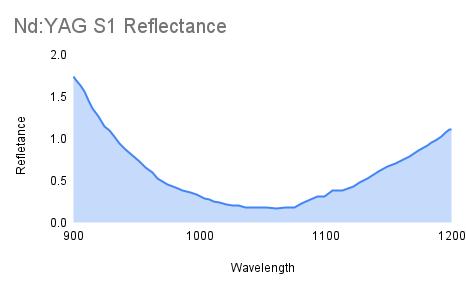Nd:YAG Crystal
Nd:YAG (neodymium-doped yttrium aluminum garnet) is a solid-state crystal commonly used as a laser medium. It is a type of crystal that, when excited by an electric current, emits light at a specific wavelength, which is used in various applications such as laser eye surgery, laser lithography, and laser hair removal.
Absorption wavelength of Nd:YAG crystal is typically around 808nm and the emission wavelength is 1064nm.
Nd:YAG lasers have several advantages, including high peak power, high repetition rate, high efficiency, low cost, compact size, and low thermal load on the laser medium.

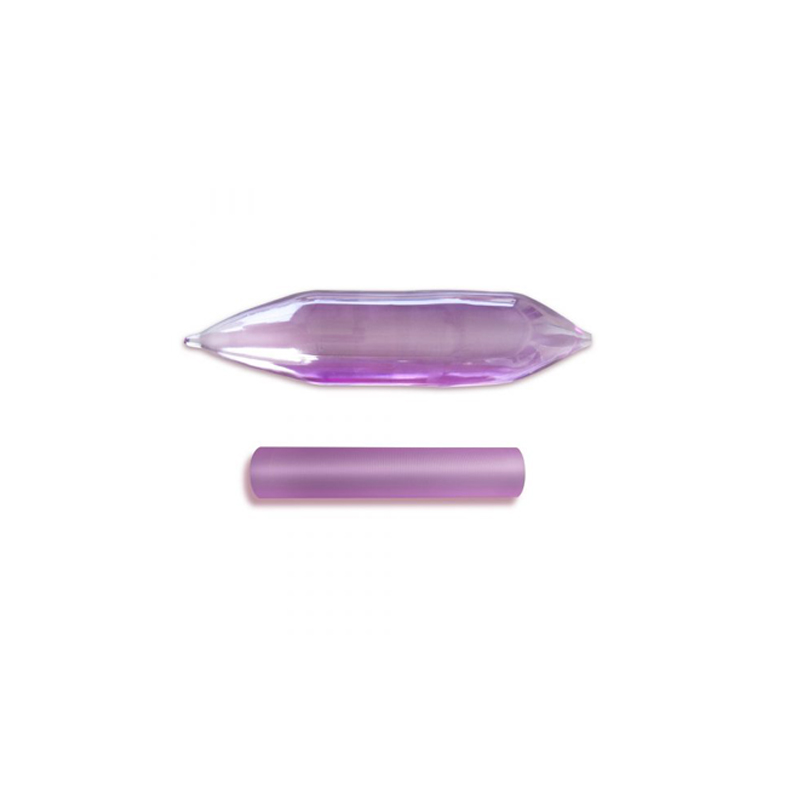
NdYAG Rod
- dia3x65mm,dopant 1.1%,AR/AR 1064 coating
| wdt_ID | SKU | Dopant(%) | Diameter(mm) | Length(mm) | Coating | Price(USD) | Leadtime | MOQs |
|---|---|---|---|---|---|---|---|---|
| 20 | ND3x10@1.1 | 1.1 | 3 | 10 | AR/AR @ 1064nm | 122 | 4-5 weeks | 10pcs |
| 21 | ND3x12@1.1 | 1.1 | 3 | 12 | AR/AR @ 1064nm | 122 | 4-5 weeks | 10pcs |
| 22 | ND3x20@1.1 | 1.1 | 3 | 20 | AR/AR @ 1064nm | 122 | 4-5 weeks | 10pcs |
| 23 | ND3x23@1.1 | 1.1 | 3 | 23 | AR/AR @ 1064nm | 122 | 4-5 weeks | 10pcs |
| 24 | ND3x25@1.1 | 1.1 | 3 | 25 | AR/AR @ 1064nm | 122 | 4-5 weeks | 10pcs |
| 25 | ND3x30@1.1 | 1.1 | 3 | 30 | AR/AR @ 1064nm | 125 | 4-5 weeks | 10pcs |
| 26 | ND3x38@1.1 | 1.1 | 3 | 38 | AR/AR @ 1064nm | 135 | 4-5 weeks | 10pcs |
| 27 | ND3x55@1.1 | 1.1 | 3 | 55 | AR/AR @ 1064nm | 185 | 4-5 weeks | 5pcs |
| 28 | ND3x65@1.1 | 1.1 | 3 | 65 | AR/AR @ 1064nm | 191 | 4-5 weeks | 5pcs |
| 30 | ND4x4x7@1.1 | 1.1 | 4 | 7 | AR/AR @ 1064nm | 152 | 4-5 weeks | 10pcs |
| 31 | ND4x4x10@1.1 | 1.1 | 4 | 10 | AR/AR @ 1064nm | 152 | 4-5 weeks | 10pcs |
| 32 | ND4x12@1.1 | 1.1 | 4 | 12 | AR/AR @ 1064nm | 152 | 4-5 weeks | 10pcs |
| 33 | ND4x30@1.1 | 1.1 | 4 | 30 | AR/AR @ 1064nm | 182 | 4-5 weeks | 10pcs |
| 34 | ND4x50@1.1 | 1.1 | 4 | 50 | AR/AR @ 1064nm | 231 | 4-5 weeks | 5pcs |
| 35 | ND4x65@1.1 | 1.1 | 4 | 65 | AR/AR @ 1064nm | 231 | 4-5 weeks | 5pcs |
| 37 | ND5x15@1.1 | 1.1 | 5 | 15 | AR/AR @ 1064nm | 211 | 4-5 weeks | 10pcs |
| 38 | ND5x26@1.1 | 1.1 | 5 | 26 | AR/AR @ 1064nm | 211 | 4-5 weeks | 10pcs |
| 39 | ND5x50@1.1 | 1.1 | 5 | 50 | AR/AR @ 1064nm | 258 | 4-5 weeks | 5pcs |
| 40 | ND5x60@1.1 | 1.1 | 5 | 60 | AR/AR @ 1064nm | 288 | 4-5 weeks | 5pcs |
Customized and Stocked NdYAG Rods in the Showcase
|
ND:YAG ROD8x100mm(1.1% with AR/AR1064nm) |
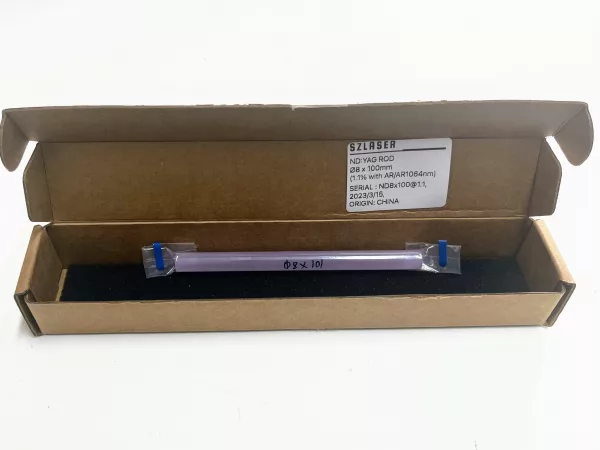 |
|
|
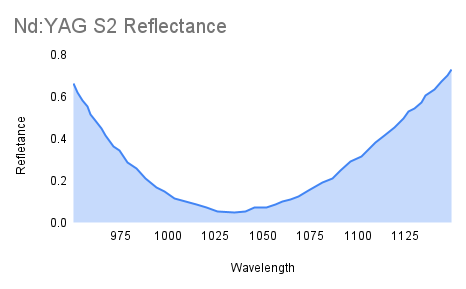 |
Nd:YAG Overview
|
Nd:YAG lasers are capable of producing high peak power pulses with a wide range of repetition rates. They are also highly efficient and can be diode-pumped for even greater energy savings. Additionally, Nd:YAG lasers are relatively inexpensive compared to other types of lasers, and their compact size makes them suitable for a variety of applications. Finally, Nd:YAG lasers have a low thermal load on the laser medium due to their efficient design., which helps to reduce thermal lensing and stress-induced birefringence. |
|
What are the components in a Nd:YAG system?
The components of an Nd:YAG laser system include an energy source (pump), active medium (laser crystal), and optical resonator. The energy source is typically a flashtube or laser diodes, while the active medium is a Neodymium-doped Yttrium Aluminum Garnet (Nd:YAG) crystal. The optical resonator consists of mirrors, such as laser line and dual band mirrors, laser rear mirrors, laser output couplers, laser harmonic separators, and laser beamsplitters. Additionally, anti-reflective coated lens kits and anti-reflection coated precision windows are also used in the system.
What are pumps for Nd:YAG?
A pump is a device used to excite the neodymium ions in the Nd:YAG crystal, causing them to emit light at 1064 nm. The pump source for an 808 nm Nd:YAG laser is typically an infrared laser diode. The laser diode emits a beam of 808 nm light, which is directed into the Nd:YAG crystal. The 808 nm light is absorbed by the neodymium ions, raising their energy level and triggering the emission of light at 1064 nm.
Pump sources for Nd:YAG lasers include krypton arc, halogen, xenon flash lamps, laser diodes.
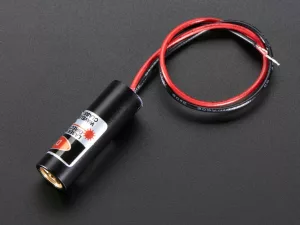
An example of Laser Diode from Adafruit
Comparing pumps for Nd:YAG Lasers
flashlamp-pumped and laser diode-pumped Nd:YAG lasers have their own advantages and disadvantages. Flashlamp-pumped Nd:YAG lasers are capable of generating high power output, but they are typically larger and less efficient than laser diode-pumped Nd:YAG lasers. On the other hand, laser diode-pumped Nd:YAG lasers are compact, efficient, and have a long operating life, but they typically have lower power output compared to flashlamp-pumped Nd:YAG lasers.
NdYAG Laser Setup
Nd:YAG (1064nm Configuration)

Nd:YAG + KTP (532nm SHG Configuration)
Using a LD with 808nm as the pump and merge the beam into Nd:YAG. The output is 1064nm, then direct the beam into KTP, the output will be 532nm (With SHG).

What is a KTP?
Potassium titanyl phosphate (KTP) is an inorganic compound with the formula KTiOPO4. It is a nonlinear optical crystal, which possesses excellent nonlinear, electrooptical and acousto optical properties. KTP crystals are most frequently used for second harmonic generation of Nd:YAG, due to their high nonlinearity, great mechanical stability, high optical quality, and wide transmission range from visible to infrared spectral region.
Laser Diode 808nm (LD808)For the efficient optical excitation of the Nd doped YAF crystal a pump wavelength of 808 nm at its full power is required. |
|
Beam CouplerThe Nd:YAG crystal is pumped by the radiation of 808 nm emitted from the laser diode. The divergent radiation is collimated to an almost parallel beam and afterwards focused by the focusing lens |
|
Reflector MirrorThe Nd:YAG laser cavity is formed by the coated back side of the Nd:YAG rod. |
|
Output Coupler MirrorOutput mirrors for Nd:YAG lasers are designed to reflect a portion of the beam back into the laser resonator for continuous amplification while transmitting a part of the circulating intracavity power |
|
FilterA filter is used to suppress the residual fundamental and pump radiation |
What is an output coupler?
Output couplers are partially transparent laser mirrors used to extract output beams from laser resonators. They are an essential component of a laser system, as they allow for the extraction of a portion of the light from the intracavity beam. Without an output coupler, it would be impossible to extract any light from the laser system. Output couplers can also be used to tune lasers by incorporating a tuning grating in Littrow configuration. Additionally, output couplers can withstand repeated Q-spoiled bursts of laser radiation without damage. Therefore, an output coupler cannot be omitted in a laser system.
Nd:YAG + Cr:YAG (Q-switch Configuration)
Below is an example of Nd:YAG + Cr:YAG bonded Crystal.
| Nd:YAG | Cr:YAG | Structure | |
|---|---|---|---|
| Dopant | 1.0% | – | 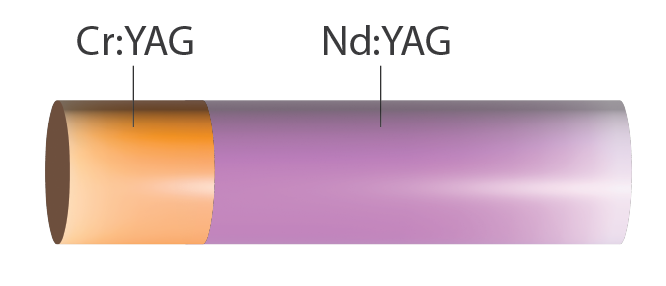 |
| Size | ⌀8 x 20mm | ⌀8 x 2mm | |
| Surface | Flat / Flat | Flat / Flat | |
| Coating | HR1064nm & HT808nm | HR808nm & HT1064nm |
A bond crystal is a product that joins two or more pieces of homogeneous substrate material with different dopants through bonding technology to achieve a stable bond. Experimentation shows that bond crystals can effectively reduce the temperature of laser crystals and decrease the impact of the thermally induced lens effect caused by end face deformation.
Advantages:
- Reduces the thermal lens effect caused by end face deformation
- Improves the light-to-light conversion efficiency
- Increases the damage threshold
- Improves the quality of the output laser beam
- Reduces the volume.
What is slope efficiency
The slope efficiency of a laser is the differential power conversion efficiency, which is obtained by plotting the laser output power against the input pump power. Above the lasing threshold, the resulting curve is usually close to a straight line and the slope efficiency is the slope of this line. It is one of the most important properties of a laser and varies from part-to-part. The slope efficiency (or differential efficiency) is defined as the slope of the curve obtained by plotting output power versus pump power.
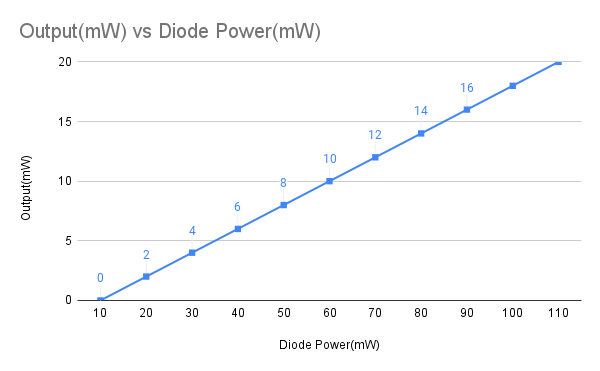
Slope Efficiency Example with 2mW Threshold and 20% Slope Efficiency
Slope efficiency of solid-state lasers
Nd:YAG ceramic lasers can obtain a high slope efficiency of 62%, while single crystal lasers have a slope efficiency of 44%. Solid-state lasers have remained a vibrant area of research due to several major innovations that expanded their capability. Efficiency factors are used to estimate threshold and slope efficiency, allowing an estimate of performance. Pure laser diode systems can reach the highest efficiencies, sometimes well above 60%, but they cannot always be used. Yb:YAG cryogenic solid-state lasers have an average threshold absorbed pump power of 18.8 mW and an average slope efficiency of 91.9%, close to the heat-fraction limit.
Example of NdYAG slope efficiency
The threshold power of a laser is 50 mW and its slope efficiency is 25%. What pump power is needed for an output power of 10 mW?
It will be 50 mW + 10 mW / 0.25 = 90 mW.
What is the threshold of the pump power of a laser?
The threshold pump power of a laser refers to the minimum amount of power required to initiate lasing action in the laser medium. This power level is necessary to achieve the population inversion in the laser medium and create the gain required for the laser to produce coherent light. The exact value of the threshold pump power depends on various factors, such as the type of laser, the laser medium, and the laser cavity design.
Nd:YAG’s Property
Physcial Property
wdt_ID Attributes Values
1
Emission Line width
4.5Å @ 1064nm
2
Emission Cross Section
2.7-8.8x10⁻¹⁹cm² Nd 1%
3
Refraction Index
1.8197 @ 1064nm
4
Fluorescence lifetime
230μs
5
Photon energy
1.86x10⁻¹⁹J @1064nm
6
Density
4.56 g/cm³
7
Melting Point
1970°C
8
Mohs Hardness
8.5
9
Crystal Structure
Cubic
10
Lattice Parameters
12.01Å
11
Specific heat(0-20)
0.59J/g.cm³
Chemcial Property
wdt_ID Attributes Values
1
Chemical Formula
Nd:Y₃Al₅O₁₂
10
Youngs Modulus
3.17x10⁴Kg/mm²
11
Thermal Expansion
Coefficient
7.8 x 10⁻⁶/K 0°C~250 °C
12
Thermal Conductivity
14 W/m/K@20 °C
10.5 W/m/K@100 °C
13
Loss Coefficient
0.003 cm⁻¹@1064 nm
14
Thermal Shock Resistance
790W/m
15
Thermal Optical
Coefficient(dn/dT)
7.3×10⁻⁶/K
16
Thermal Expansion
Coefficient
7.8x10⁻⁶/K 0°C~250 °C
17
Thermal Conductivity
14 W/m/K@20°C
10.5 W/m/K@100°C
18
Solubility
Water: Insoluble
Common Acids: Slightly
Coating Curves
Below are example coating on Surface1 and Surface2 of NdYAG. However, you may not always need to do coating on NdYAG. Seperated laser outpout coupler and NdYAG laser line mirror are preferable. (To reduce Thermal effect and Cost)
Absorption and Emission of NdYAG
Nd:YAG is a type of laser that absorbs mostly in the bands between 730–760 nm and 790–820 nm. The most common Nd:YAG emission wavelength is 1064 nm.
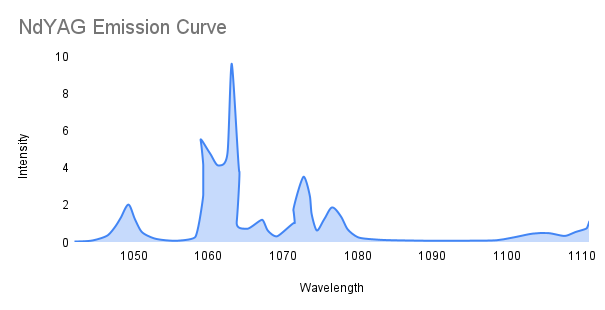
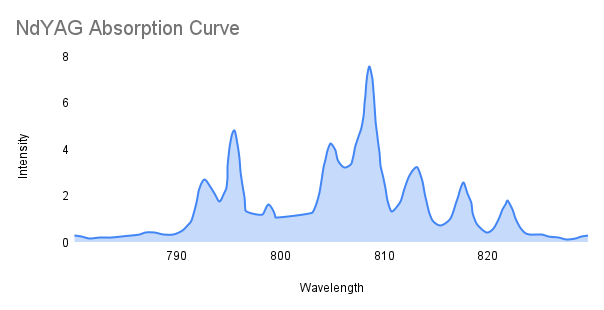
Meaning of “Absorption” and “Emission”
Absorption involves the absorbing of energy by electrons. When an atom absorbs energy, its electrons gain energy and jump to higher energy levels . Emission refers to the release of energy by electrons. When an electron releases energy by moving to a lower energy level within an atom, it produces a photon.
Simply: NdYAG take in a Light at certain wavelength (usually 808nm) and Emit Light (usually 1064nm) at another wavelength

